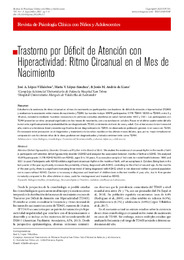Por favor, use este identificador para citar o enlazar este ítem:
https://hdl.handle.net/11000/27647Registro completo de metadatos
| Campo DC | Valor | Lengua/Idioma |
|---|---|---|
| dc.contributor.author | López Villalobos, José A. | - |
| dc.contributor.author | López Sánchez, María V. | - |
| dc.contributor.author | Andrés de Llano, Jesús M. | - |
| dc.contributor.other | Departamentos de la UMH::Psicología de la Salud | es_ES |
| dc.date.accessioned | 2022-09-20T11:13:58Z | - |
| dc.date.available | 2022-09-20T11:13:58Z | - |
| dc.date.created | 2022-09 | - |
| dc.identifier.citation | Revista pcna, vol.9, nº3, 2022 | es_ES |
| dc.identifier.issn | 2340-8340 | - |
| dc.identifier.uri | https://hdl.handle.net/11000/27647 | - |
| dc.description.abstract | Estudiamos la existencia de ritmo circanual en el mes de nacimiento en participantes con trastorno de déficit de atención e hiperactividad (TDAH) y analizamos la asociación entre meses de nacimiento y TDAH. La muestra incluye 10978 participantes (1778 TDAH / 9200 no TDAH), entre 3 y 18 años, reclutados mediante muestreo consecutivo de primeras consultas atendidas en salud mental entre 1992 y 2021. Los participantes con TDAH presentan un ritmo circanual significativo en los meses de nacimiento, con una acrofase en octubre. Nacer en el último cuatrimestre del año incrementa significativamente la probabilidad de ser diagnosticado TDAH, controlando el efecto de sexo y edad. Con el transcurso de los meses del año, existe una tendencia lineal creciente significativa de ser diagnosticado de TDAH, no observada en población general, ni en casos sin TDAH. Es necesario tener precaución en el diagnóstico y tratamiento de los niños nacidos en los últimos meses del año, que, por su mayor inmadurez en comparación con los demás niños de la clase, pudieran ser diagnosticados y tratados erróneamente como TDAH | es_ES |
| dc.description.abstract | Attention Deficit Hyperactivity Disorder: Circannual Rhythm in the Month of Birth. We studied the existence of circanual rhythm in the month of birth in participants with attention deficit hyperactivity disorder (ADHD) and analyzed the association between months of birth and ADHD. We analyzed 10,978 participants (1,778 ADHD/9,200 non-ADHD), aged 3 to 18 years. A consecutive sample of first visits to mental health between 1992 and 2021 is used. Participants with ADHD exhibit a significant circannual rhythm in the months of birth, with an acrophase in October. Being born in the last quarter of the year significantly increases the probability of being diagnosed with ADHD, controlling for the effect of sex and age. As the months of the year go by, there is a significant increasing linear trend of being diagnosed with ADHD, which is not observed neither in general population nor in cases without ADHD. Caution is necessary in diagnosis and treatment of children born in the last months of year, who, due to their greater immaturity compared to the other children in class, could be misdiagnosed and treated as ADHD | es_ES |
| dc.format | application/pdf | es_ES |
| dc.format.extent | 8 | es_ES |
| dc.language.iso | spa | es_ES |
| dc.publisher | Universidad Miguel Hernández de Elche | es_ES |
| dc.rights | info:eu-repo/semantics/openAccess | es_ES |
| dc.rights.uri | http://creativecommons.org/licenses/by-nc-nd/4.0/ | * |
| dc.subject | ritmo biológico | es_ES |
| dc.subject | cronobiología | es_ES |
| dc.subject | Trastornos del Neurodesarrollo | es_ES |
| dc.subject | evolución | es_ES |
| dc.subject | infancia y adolescencia | es_ES |
| dc.subject | biological rhythm | es_ES |
| dc.subject | chronobiology | es_ES |
| dc.subject | Neurodevelopment Disorders | es_ES |
| dc.subject | evolution | es_ES |
| dc.subject | childhood and adolescence | es_ES |
| dc.subject.other | 159.9 - Psicología | es_ES |
| dc.title | Trastorno por Déficit de Atención con Hiperactividad: Ritmo Circanual en el Mes de Nacimiento | es_ES |
| dc.type | info:eu-repo/semantics/article | es_ES |

Ver/Abrir:
2237_4.pdf
363 kB
Adobe PDF
Compartir:
 La licencia se describe como: Atribución-NonComercial-NoDerivada 4.0 Internacional.
La licencia se describe como: Atribución-NonComercial-NoDerivada 4.0 Internacional.
.png)